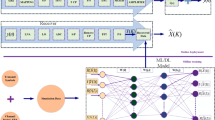Abstract
This paper proposes a narrowband interference (NBI) suppression algorithm for Direct Sequence-Code Division Multiple Access systems. The NBI is considered from heterogeneous networks, and predicted based on its cyclostationary characteristic using a nonlinear feed-forward neural network predictor which eliminates the nonlinearity of the spread spectrum (SS) signal in the NBI prediction. To further improve the suppression performance, this paper exploits the structure of the spreading code, and proposes an iterative code-aided algorithm to jointly estimate the NBI and the SS signal. Simulation results reveal that the proposed algorithm largely outperforms the conventional linear prediction filtering and linear-conjugate linear polyperiodically time-varying filtering methods in both the signal to interference plus noise ratio improvement and the bit error rates, when it operates in NBI-contaminated environments.
Similar content being viewed by others
References
Mitola J. (2009) Cognitive radio architecture evolution. Proceedings of the IEEE 97(4): 626–641
Nishimori, K., Yomo, H., Popovski, P., Takatori, Y., Prasad, R., & Kubota S. (2008). Interference cancellation and avoidance for secondary users co-existing with TDD-based primary systems. Springer Wireless Personal Communications (special issue on Cognitive Radio Technologies).
Li T., Mow W. H., Lau V. K. N., Siu M., Cheng R. S., Murch R. D. (2007) Robust joint interference detection and decoding for OFDM-based cognitive radio systems with unknown interference. IEEE Journal on Selected Areas in Communications 25(3): 566–575
Yang, Z., Zhao, T., & Zhao, Y. (2010). Narrowband interference suppression for OFDM systems with guard band. In Proceedings of IEEE Vehicular Technology Conference: VTC2010-Fall, Ottawa, Canada (pp. 1–5).
Milstein L. B. (1988) Interference rejection techniques in spread spectrum communications. Proceedings of the IEEE 76(6): 657–671
Rush L. A., Poor H. V. (1994) Narrowband interference suppression in CDMA spread spectrum communications. IEEE Transactions on Communications 42(234): 1969–1979
Chang P. -R., Hu J. -T. (1999) Narrowband interference suppression in spread spectrum CDMA communications using pipelined recurrent neural network. IEEE Transactions on Vehicular Technology 48(2): 467–477
Perez-Solano J. J., Felici-Castell S., Rodriguez-Hernandez M. A. (2008) Narrowband interference suppression in frequency- hopping spread spectrum using undecimated wavelet packet transform. IEEE Transactions on Vehicular Technology 57(3): 1620–1629
Shayesteh M. G., Nasiri-Kenari M. (2009) Multiple-access performance analysis of combined time-hopping and spread-time cdma system in the presence of narrowband interference. IEEE Transactions on Vehicular Technology 58(3): 1315–1328
Iltis R. A., Milstein L. B. (1985) An approximate statistical analysis of the Widrow LMS algorithm with application to narrow-band interference rejection. IEEE Transactions on Communications 33(2): 121–130
Gardner W. A. (1990) Introduction to random processes with applications to signals and systems (2nd ed.). McGraw-Hill, New York, USA
Gardner, W. A. (1994). Cyclostationarity in communications and signal processing. Piscataway, NJ: IEEE.
Gelli G., Izzo L., Paura L. (1996) Cyclostationarity-based signal detection and source location in non-Gaussian noise. IEEE Transactions on Communications 44(3): 368–376
Geli G., Paura L., Tulino A. M. (1998) Cyclostationarity-based filtering for narrow-band interference suppression in direct-sequence spread-spectrum systems. IEEE Journal on Selected Areas in Communications 16(9): 1747–1755
Zhang, L., & Zhang, J. (2008). A suppressing NBI technique of DSSS based on the linear estimator in time-frequency domain). In Proceedings of IEEE International Conference on Wireless Communications, Networking and Mobile Computing, Dalian, P. R. China (pp. 1–4).
Lapedes, A., & Farber, R. (1987). Nonlinear signal processing using neural networks: Prediction and modeling. Technical Report, LA-UR87-2662. Los Alamos, New Mexico: Los Alamos National Laboratory.
Connor J. T., Martin R. D., Atlas L. E. (1994) Recurrent neural networks and robust time series prediction. IEEE Transactions on Neural Networks 5(2): 240–254
Xu, D., Zhao, P., Shen, F., & Zhao, H. (2008). Narrowband interference suppression using RKF-based recurrent neural network in spread spectrum system. In Proceedings of IEEE International Conference on Wireless Communications, Networking and Mobile Computing, Dalian, P. R. China (pp. 1–5).
Yang, Z., Zhao, T., Zhao, Y., & Yu, J. (2010). Iterative narrowband interference suppression for ds-cdma systems using feed-forward neural network. In Proceedings of IEEE Vehicular Technology Conference: VTC2010-Spring, Taipei, Taiwan (pp. 1–5).
Vijayan R., Poor H. V. (1990) Nonlinear techniques for interference suppression in spread-spectrum systems. IEEE Transactions on Communications 38(7): 1060–1065
Zeidler J. R., Satorius E. H., Chabries D. M., Wexler H. T. (1978) Adaptive enhancement of multiple sinusoids in uncorrelated noise. IEEE Transactions on Acoustics, Speech and Signal Processing 26(3): 240–254
Widrow B., McCool J., Ball M. (1975) The complex LMS algorithm. IEEE Transactions on Signal Processing 63(4): 719–720
Gardner W. A. (1993) Cyclic Wiener filtering: Theory and method. IEEE Transactions on Communications 41(1): 151–163
Aazhang B., Paris B. P., Orsak G. C. (1992) Neural networks for multiuser detection in code-division multiple-access communications. IEEE Transactions on Neural Networks 40(7): 1212–1222
Rumelhart D. E., Hinton G. E., Williams R. J. (1986) Learning internal representation by error propagation. MIT Press, Cambridge, MA
Benvenuto N., Piazza F. (1992) On the complex backpropagation algorithm. IEEE Transactions on Signal Processing 40(4): 967–969
Schell, S. V., & Gardner, W. A. (1990). Progress on signal-selective direction finding. In Proceedings of IEEE fifth ASSP Workshop Spectral Estimation and Modeling, Rochester, NY (pp. 144–148).
Sahai, A., & Cabric, D. (2005). Cyclostationary feature detection. Tutorial presented at the IEEE DySPAN 2005 (Part II). http://www.eecs.berkeley.edu/sahai/Presentations/DySPAN05part2.ppt.
Author information
Authors and Affiliations
Corresponding author
Rights and permissions
About this article
Cite this article
Yang, Z., Zhang, X. & Zhao, Y. Cyclostationarity-Based Narrowband Interference Suppression for Heterogeneous Networks Using Neural Network. Wireless Pers Commun 68, 993–1012 (2013). https://doi.org/10.1007/s11277-011-0495-0
Published:
Issue Date:
DOI: https://doi.org/10.1007/s11277-011-0495-0




